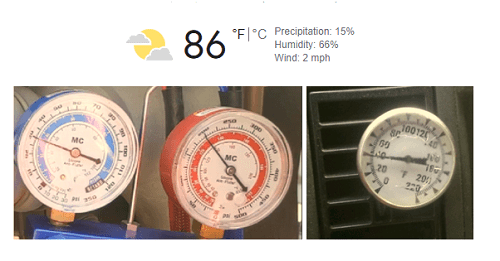Refrigerant capacity and mobile A/C service: part 2
By Richard Hawkins, MACS contributor
Note: This is a continuation of last week’s article. It would be best to read that one before reading this one (if you haven’t already done so at this link: https://macsmobileairclimate.org/2021/06/08/refrigerant-capacity-and-mobile-a-c-service/
A real-lfe tech line scenario
The article started off with the following: One of the most frequently asked questions on tech help-line calls concerns refrigerant capacity: How much refrigerant is in that mobile A/C system, and have you checked to be sure the refrigerant is pure?
The answers can sometimes be interesting and can lead in multiple directions.
Technician C: The system has a full charge in it.
Me: You charged the system with 20 ounces of refrigerant. Right? Note: This is a different vehicle from the one in last week’s article.
Technician C: I don’t know exactly how much refrigerant is in it. I charged it until the pressures looked good while it was running, so that means it has a full charge.
Me: We need to discuss that. What are your pressure readings and what is the ambient temperature there and the humidity?
Technician C: The high side is running at 205 and the low side is at 34. The temperature outside is 85 degrees. I don’t know what the humidity is. Let me Google on my phone and see what it says, 64%. I always try to shoot for about 200 on the high side and between 30 and 35 on the low side, so I’m pretty close.
Me: System operating pressures cannot be used to determine the amount of refrigerant charge in an A/C system. Sure, if you have an extremely low high side reading and an extremely low, low side reading, that is a sign of an extremely low charge. Likewise, if you have an extremely high, high side reading and an extremely high, low side reading, that is a sign of an overcharge. But the amount of charge cannot be determined to be correct because the pressures look “good”.
Technician C: Why not?
Me: Ambient temperature and humidity have a huge effect on system operating pressures. Consider that on a mild day with 70 degrees ambient temperature and 40% humidity, a system might operate at 150 on the high side and 28 on the low side (with the correct charge).
Using your method, if you charge it by pressures, you will be adding refrigerant until the high side gets to around 200 and the low side to about 30 and it may cool just fine. But what if the ambient temperature gets up to 100 degrees with 85% humidity a few days later? The high side could be operating at over 400 and the low side will be elevated, and it isn’t going to cool very good. So, trying to charge a system by pressures in mild conditions is most likely going to result in an overcharge.
Now let’s apply that to charging it by pressures on a 100-degree day with 85% humidity: In those conditions, the system might operate at 275 on the high side and 38 on the low side (with the correct charge).
By charging it by pressures, you are going to stop adding refrigerant when the pressures get in those 200 high sides and about 30 to 35 low side ranges and it may be cooling good, but it will have a low charge in it.
Technician C: Well, if it’s cooling good, how can it have a low charge in it? Even if it does, if it is cooling good, why does it matter?

The pressures (HS: 200PSI, LS: 30PSI) & vent temperature (40 degrees) are fine. But they CANNOT be used to make a determination that the A/C system has a full charge of refrigerant.
Me: Because systems can cool quite well in an undercharged state, and it matters because the compressor can be compromised due to increased operating temperatures and a lack of oil flowing to it.
Check back in next week and we will explain this in detail utilizing results from a test we ran.
If you like what you see on the MACS blog, you’ll have access to lots more if you become a member!
Join us here at this link: https://macsmobileairclimate.org/membership

Leave a Reply